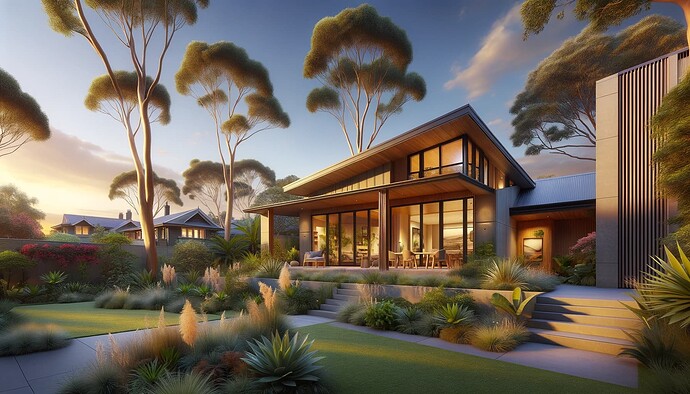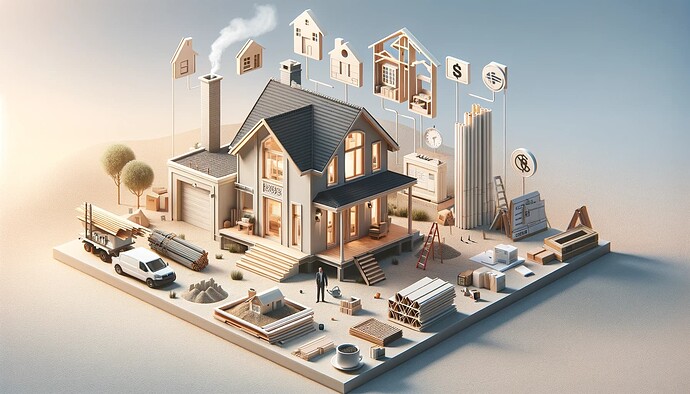How Much Does It Cost to Build a House in Australia?
Building a house in Australia is a significant financial investment that requires careful planning and consideration. Many factors come into play when determining the construction cost, such as location, house size, design, materials, and additional expenses. In this article, we will explore these aspects to understand the various components contributing to the overall cost of building a house in Australia.
Understanding the Basics of House Building Costs
When building a house, location is crucial in determining the cost. Different states and regions in Australia have varying land prices, construction regulations, and availability of skilled labour, all of which influence the final cost.
Let’s delve deeper into how these factors affect the overall expenses. Land prices can vary significantly depending on the area. In metropolitan cities like Sydney and Melbourne, land prices are generally higher compared to regional areas. This is due to the high demand for housing and the limited availability of land. On the other hand, in rural areas, land prices tend to be more affordable, making it an attractive option for those looking to build a house on a budget.
Construction regulations
Construction regulations also play a vital role in determining the cost of building a house. Each state and local government has its own set of regulations and building codes that must be followed. These regulations ensure that the construction meets safety standards and environmental requirements. However, complying with these regulations may require additional expenses, such as hiring professionals to obtain permits and conduct inspections.
Skilled Labour
The availability of skilled labour is another factor that affects house-building costs. In areas with a shortage of skilled workers, contractors may have to pay higher wages to attract and retain qualified tradespeople. This increase in labour costs can significantly impact the overall expenses of the project.
House Size
Additionally, the impact of house size on cost cannot be underestimated. The larger the house, the more materials and labour will be required, increasing overall expenses. Building a larger house also means more time spent on construction, which can lead to higher labour costs.
Design
Furthermore, the design and choice of materials significantly contribute to the cost calculation. A more intricate and complex design will require skilled labour and specialized construction techniques, adding additional costs. Architects and designers may charge higher fees for creating unique and customized designs, increasing overall expenses.
Choice of Materials
The choice of materials also plays a crucial role in determining the house’s cost. High-end finishes and luxurious materials, such as marble countertops or hardwood flooring, can significantly increase the expenses. On the other hand, opting for eco-friendly alternatives, such as energy-efficient windows or sustainable building materials, may have higher upfront costs but can result in long-term savings on energy bills.
It is important to consider these factors carefully when planning to build a house. Understanding the basics of house building costs allows you to make informed decisions and ensure your project stays within your budget.
Breaking Down the Construction Costs
When building a house in Australia, understanding the components that make up the construction costs is essential. Let’s delve deeper into each stage of the construction process to gain a comprehensive understanding.
Land Preparation and Foundation Costs
Before any construction can begin, the land must undergo a series of preparations. This includes site clearing, excavation, and levelling. The cost of land preparation can vary depending on the size and condition of the site. Additionally, the type of soil and site conditions can also affect the cost of foundations. Some areas may require deeper or reinforced footings to ensure the stability and longevity of the house.
It’s important to note that the presence of trees, rocks, or other obstacles on the site can also impact the land preparation costs. Clearing such obstacles may require additional labour and equipment, increasing overall expenses.
Framing and Exterior Finishing Costs
The framing stage is where the house structure starts to take shape. This involves erecting the walls, roof, and internal framework. The cost of framing is determined by various factors, including the size and complexity of the design, as well as the materials used.
Exterior Finishing Costs
When it comes to exterior finishing, there are several elements to consider. Cladding, roofing, windows, doors, and external paintwork all contribute to the overall appearance and functionality of the house. The cost of exterior finishing will depend on the materials chosen, the level of customization, and any additional features or enhancements desired.
Interior Finishing Costs
Once the structure is complete, it’s time to focus on the interior finishes. This stage covers the materials and labour required for flooring, cabinetry, plumbing fixtures, electrical fittings, tiling, painting, and other finishes. The level of customization and the quality of finishes will influence the overall cost.
There is a wide range of flooring options, including hardwood, laminate, carpet, and tile. The cost will depend on the type of material selected and the size of the area to be covered. Similarly, the cost of cabinetry will vary based on the materials, design complexity, and the number of cabinets needed throughout the house.
System Installation Costs
Installing essential systems and utilities is a crucial stage of construction. This includes plumbing, electrical, heating, ventilation, and air conditioning. The complexity of the systems required and the size of the house will determine the installation costs.
For example, a larger house may require extensive plumbing to accommodate multiple bathrooms and kitchens. Similarly, the electrical system will need to be designed and installed to meet the specific power requirements of the house. The cost of these installations will depend on the complexity of the design, the materials used, and the labour involved.
Construction cost breakdown
By understanding the breakdown of construction costs, homeowners can make informed decisions and effectively manage their budget throughout the building process. It’s important to note that these costs can vary significantly depending on factors such as location, design complexity, and the level of customization desired. Consulting with professionals and obtaining detailed quotes from contractors is crucial to ensure accurate budgeting and a successful construction project.
Additional Costs to Consider
In addition to the construction costs, there are several other expenses to consider when building a house in Australia.
Building a house is an exciting endeavour, but knowing the additional costs can arise throughout the process is important. These costs can vary depending on factors such as the size and complexity of the project, as well as the location of the build.
Landscaping and Outdoor Structures
Creating an attractive and functional outdoor space is essential for many homeowners. Landscaping costs can include designing and installing gardens, lawns, fences, decks, and outdoor entertaining areas.
When it comes to landscaping, there are endless possibilities. The choices are vast, from lush gardens filled with vibrant flowers to serene water features that create a sense of tranquillity. However, it’s important to remember that these additions come with a price tag. The cost of landscaping can vary depending on the size of the area to be landscaped, the materials used, and the complexity of the design.
For example, suppose you’re looking to create a backyard oasis complete with a swimming pool. In that case, you’ll need to factor in the cost of excavation, pool installation, and additional features, such as a pool house or outdoor kitchen.
Permits and Inspection Fees
Obtaining the necessary permits and approvals from local authorities is vital in the construction process. These permits, as do the mandatory inspections throughout the building stages, often come with associated fees.
Before construction can begin, you’ll need to obtain various permits, such as building, plumbing, and electrical permits. These permits ensure that your project complies with local building codes and regulations. The cost of these permits can vary depending on the size and scope of your project.
In addition to the initial permits, inspection fees are also to be considered. Throughout the construction process, local authorities will conduct inspections to ensure the work is done correctly and safely. These inspections come with fees that can add up over time.
Unexpected Costs and Contingency Budget
It is wise to allocate a contingency budget to account for unforeseen expenses or construction changes. Factors such as delays, design modifications, or unexpected site conditions can all lead to additional costs.
Building a house is a complex process, and it’s not uncommon for unexpected issues to arise. For example, during the excavation phase, you may discover that the soil is unstable and requires additional reinforcement. Or, you may decide to change the original design, which can result in additional costs for materials and labour.
By setting aside a contingency budget, you can ensure you have the financial flexibility to handle these unforeseen expenses without derailing your entire project. It’s recommended to allocate 10-15% of your total construction budget for contingencies.
Building a house is an investment, and it’s important to plan and budget accordingly. Considering these additional costs, you can ensure that you’re prepared for any financial surprises that may arise during construction.
Ways to Save on Building Costs In Australia
While building a house is a substantial investment, there are ways to optimize costs without compromising quality.
Choosing a Simple Design
Selecting a simple design can help reduce construction costs. Complex architectural features, intricate rooflines, and irregular shapes can add additional expenses in materials and labour.
Opting for Cost-Effective Materials
A wide range of building materials are available, each with varying price points. Opting for cost-effective materials without sacrificing quality can help keep the building costs in check.
Hiring a Reputable Builder
Engaging a reputable and experienced builder is crucial, as they can offer valuable insights and cost-saving suggestions throughout the construction process. Their expertise can help streamline the project and avoid costly mistakes.
Building a house in Australia is an exciting endeavour. By understanding the various factors influencing the cost and exploring ways to optimize expenses, homeowners can embark on their dream of creating a home that suits their needs and budget.



